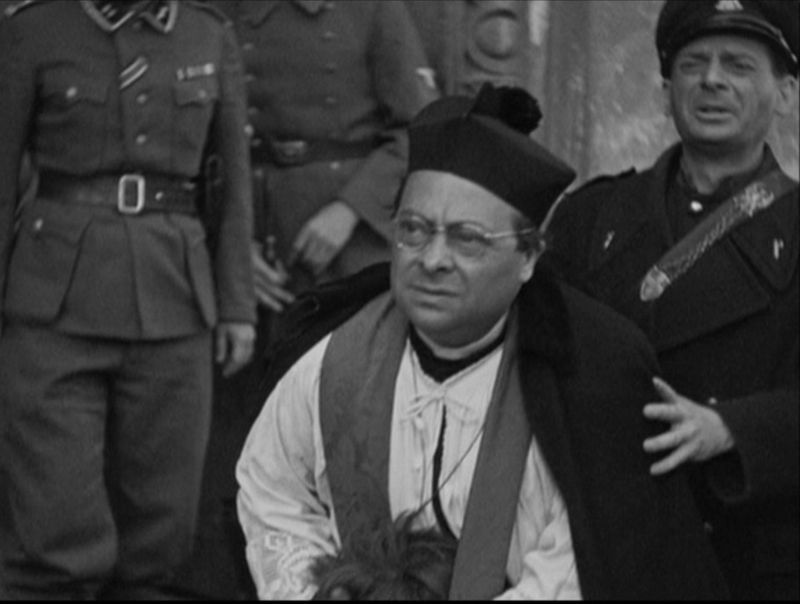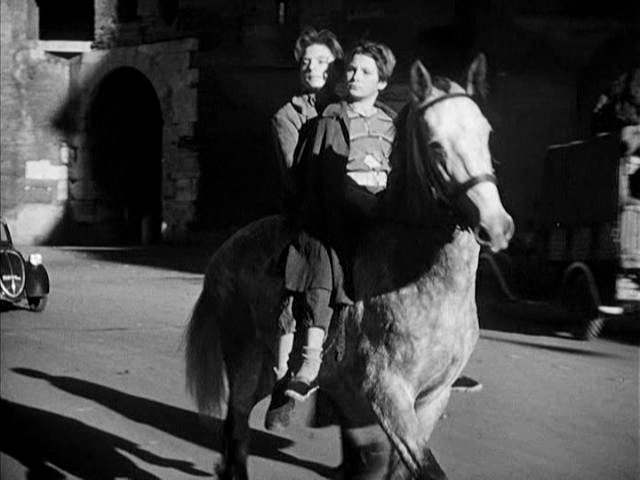Hollywood motion pictures that immediately preceded WWII were basically decorative and a kind of falsifying cosmetic that bore little resemblance to the post war trauma and destruction that had occurred. One had to look elsewhere….
By far the most impressive foreign pictures of the 1945-1950 period of post-war delapidation and regenesis were those made by the Italian neo-realists who, refusing to dodge the issues by intoxicating themselves with pretty pipe dreams and resonant extravaganzas, looked unflinchingly at the way things really were: chaotic, ignoble,decayed,and ragged at the edges.

---Watching the restored Rome, Open City, from 1945,I was struck by its two-part structure, and the way the first part recounts events taking place over a matter of days, while the second part's happenings are a matter of hours. It's true that this film presents what we've come to call neo-realism in an inchoate stage, but I found the tension between the film's florid melodramatic elements (most notably the "seduction" of Marina by the female Gestapo operative) and its jolts of no-nonsense frankness (the little boy on the chamber pot, the lambs to the slaughter) very telling. --- Read More:http://somecamerunning.typepad.com/some_came_running/2010/01/and-we-are-not-saved-rossellinis-war-trilogy.html
Through their films, mobs of unchildlike children roved in clothes too big for them: a precociously crafty and rapacious band of waifs worked with black-market hoodlums in Vittorio De Sica’s Shoeshine; in Roberto Rossellini’s memorable Open City, boys from a parochial school watched through a barbed wire fence as their priest, a partisan, was shot by a German firing squad; the resignation of their dry eyes teestifying to other monstrous things they had seen.
De Sica’s camera and Rossellini’s, and those of Fredrico Fellini, Luigi Zampa, and Renato Castellani, picked up the empty Roman plazas, the murky courtyards, and the haunting fountains, the dazed faces of ordinary people on trolley cars, rangy cats walking cleverly over skylights, tides coming in, religious processions through country towns,dispirited prostitutes, and drunk GIs. Sick babies howled in wretched tenements where the blistered wlls sweated; women pawned their sheets; pld men sold their treasured books; hungry crowds looted bakeries; hope, when it was painfully born, was short lived; and although the national persuasion to sing was irrepressible, arias from Puccini and Verdi were heard in counterpoint to the military music of the Fascisti. Nothing was certain and fear was quotidian.

---The banality of evil in Shoeshine is manifested as a disregard and objectification of the young prisoners by the overwhelmed bureaucrats. Some of the boys, such as Giuseppe and Pasquale, have done nothing to merit such harsh punishment, while others have committed serious crimes. It's clear, however, that most of the criminal activity is an outgrowth of the severe economic depression that Italy is suffering after the war. The burgeoning black market, with its huge loss of taxable income, is a natural target for law enforcement. Criminals both real and imaginary, including the huge population of newly orphaned children, are relentlessly pursued and incarcerated in numbers so great that the whole penal system is on the verge of collapse. The movie, on one level, investigates the social and individual human cost of a state policy that ultimately dehumanizes those on both sides of the law. On another level, viewed as a film about relationships, it's the moving story of a friendship torn apart by misunderstanding and foolish choices. Either way, the film is heartbreakingly effective.--- Read More:http://www.dvdverdict.com/reviews/shoeshine.php
These surgical and uncompromising probings of a society’s ulcerated wounds were not accepted gratefully by Italian audiences, who wanted to wake from the nightmare of how life was into a dream of how it might be in a nver-never land of sweetness and light and fun and games; they wanted cheesecake, not bitter rice.
But despite the apathy of their countrymen, these radical directors continued to hold up to the public its flawed, twisted and often heroic image. The products of their devotion included, besides Shoeshine and Open City, ROssellini’s Paisan, a group of unrelated and unfinished episodes during the last years of the war as the Allies moved north from Sicily to the Po Valley; Di Sica’s profoundly disturbing Bicycle Thief, the tragedy of a laborer who, bereft of his bicycle, is bereft also of his job and who, in the hopeless search for the stolemn machine, turns on his small son in a fury of frustration, introducing the boy to the pain of unkindness that is not deserved.

The Bicycle Thief. ---So, if you do not have the eyes to see, you are free to attribute whatever happens to bad luck or to chance. The same applies to the people in the film. The worker is just as deprived and isolated among follow trade unionists as he is walking along the street or even in that ineffable scene of the Catholic "Quakers" into whose company he will shortly stray, because the trade union does not exist to find lost bikes but to transform a world in which losing his bike condemns a man to poverty. Nor does the worker come to lodge a complaint with the trade union but to find comrades who will be able to help him discover the stolen object. So here you have a collection of proletarian members of a union who behave no differently from a group of paternalistic bourgeois toward an unfortunate workman. In his private misfortune, the poster hanger is just as alone in his union as in church (buddies apart, that is but then who your buddies are is your own affair.) But this parallel is extremely useful because it points up a striking contrast. The indifference of the trade union is normal and justified because a trade union is striving for justice not for charity. But the cumbersome paternalism of the Catholic "Quakers" is unbearable, because their eyes are closed to his personal tragedy while they in fact actually do nothing to change the world that is the cause of it. On the most successful scene is that in the storm under the porch when a flock of Austrian seminarians crowd around the worker and his son. We have no valid reason to blame them for chattering so much and still less for talking German. But it would be difficult to create a more objectively anticlerical scene.--- Read More:http://kit.kein.org/node/366 image:http://www.moma.org/collection/browse_results.php?criteria
Umberto D., also the work of De Sica, is the portrait of a broke and friendless and homeless old man, marred by sentimentality but having nonetheless a great many dr
ic details and photographic virtues. There were somewhat later, Fellini’s I Vitelloni, Cabiria, and his most famous, La Strada, a pathetic and Grand Guignol story of a free-lance strong man, played by Anthony Quinn, and a simple and simple minded girl, played by Giulietta Masina, and their rural peregrinations from circuses to fairs to country weddings.







 COMMENTS
COMMENTS



